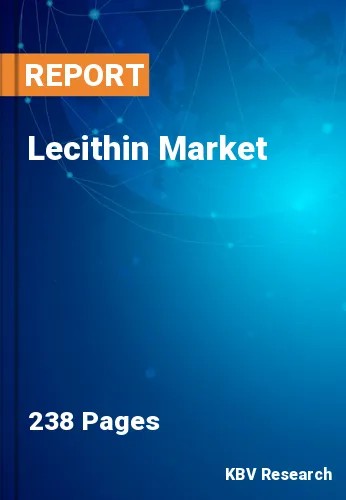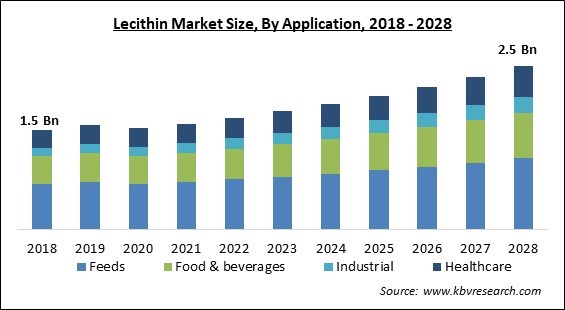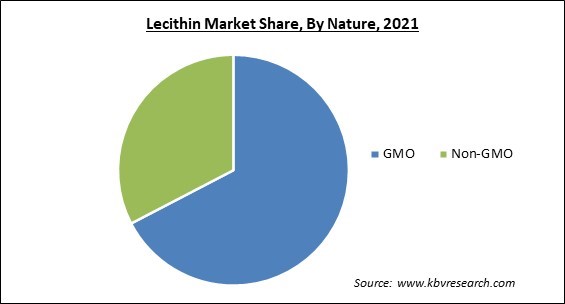
The Global Lecithin Market size is expected to reach $2.5 billion by 2028, rising at a market growth of 6.6% CAGR during the forecast period.
Lecithin is a form of fat that is essential for the body's cells. Phosphatidylethanolamine, phosphatidic acid, phosphatidylserine, phosphatidylcholine, and phosphatidylinositol are a few examples of glycerophospholipids. Fat is thought to be effective in the treatment of a variety of disorders, including liver disease, eczema, and liver disease. Phospholipid, also known as Phosphatide, is a lipid molecule that is an important part of the cell membrane. The composition of lipid molecules includes two alcohols, a phosphate group, and one or more fatty acids.
Phospholipids from natural items such as eggs, soy, and sunflower are extracted and processed to make lecithin. Lecithin also has lipophilic and hydrophilic characteristics and resembles oil and water in distinct ways. It is widely used in a variety of industries, including pharmaceuticals, food, nutrition, supplements, and cosmetics.
Lecithin is a substance that has been used in medication development and is frequently used in pharmaceutical production. Alzheimer's disease and dementia are two conditions that lecithin is utilized to treat. It is used to treat eczema, liver disease, gallbladder disease, depression, high cholesterol, and anxiety. Lecithin is often used as a food additive to prevent the separation of ingredients. In the production of ready-to-eat meals and processed meats, it can also be employed as a lubrication agent or emulsifier. Commercial lecithin is made from lecithin, as well as other relevant phospholipids and oil.
Because of its ability to break up fat and oil globules along with its antioxidant properties, lecithin derived from soybeans is vital in the industrial preparation of food and other products. Without lecithin, these elements tend to separate. A well-known example is the separation of fats from chocolate, which creates a light oily coating on the surface. Lecithin prevents oils from oxidation throughout processing, giving them a richer flavor and a longer shelf life. Lecithin is used in a variety of products, including paints, leather goods, dyes, inks, plastics, textiles, cosmetics, and pharmaceuticals.

The COVID-19 pandemic caused a severe impact on various economies all over the world. Several businesses were significantly devastated as a result of the outbreak of the COVID-19 infection. In addition, the governments of several countries were forced to impose lockdowns in their nations. As a result, the manufacturing units of numerous goods were temporarily shut down. Moreover, these lockdowns also caused a major disruption in the supply chain of various goods. Further, COVID-19 led the worldwide healthcare industry to a significant failure due to the shortage of beds and oxygen in hospitals.
Consumer awareness of the negative effects of chemical compounds, as well as the availability of organic or natural substances as alternatives on the market, is driving the demand for various natural fruit and vegetable additives. When purchasing food and beverage goods, consumers look for terms like additive-free and natural. Because of increased consumer awareness, ingredient labeling has become necessary in various developed and developing economies. Moreover, natural products and ingredients that taste delicious and have lesser calories are sought by consumers. Despite the fact that artificial or non-organic substances have garnered widespread public adoption along with a major market presence, natural alternatives are required to substitute these artificial ingredients.
The demand for the pharmaceuticals industry is surging due to the fact that the high dietary values in lecithin aid in improving HDL cholesterol levels and lowering LDL cholesterol levels. Lecithin supplements are also considered to enhance immune system function, particularly in diabetics. Lecithin is classified as generally recognized as safe (GRAS) by the US Food and Drug Administration. When consumed in small doses, it does not usually cause any kind of side effects. This is aiding in the spread of knowledge about the use of lecithin as a dietary supplement.
For the manufacturing of lecithin, manufacturers use a variety of plant sources such as soy, sunflower, and rapeseed. Large quantities of these basic resources are available all over the market. The producers' profit margin is hampered by shifting raw material prices. End-user firms, particularly those in the food industry, require high-quality lecithin at reasonable pricing in order to deliver the final output to worldwide customers and consumers. As the cost of raw ingredients rises, the cost of processing lecithin and turning them into final goods also surges, resulting in an increased selling price.

Based on Application, the market is segmented into Feeds, Food & beverages, Industrial, and Healthcare. In 2021, the food and beverages segment procured a significant revenue share of the lecithin market. Chocolates, fudge, toffee, caramels, and brittles are a few examples of confectionery products that include lecithin. Its capacity to serve as a natural antioxidant, emulsifier, and taste enhancer is driving the demand for the product across the confectionery industry. Moreover, the rapidly increasing sugar-free confectionery business is also expected to have a beneficial impact on the demand for lecithin. Therefore, these factors would augment the growth of this segment.
Based on Nature, the market is segmented into GMO and Non-GMO. In 2021, the GMO segment acquired the largest revenue share of the lecithin market. Lecithin, a natural emulsifier used in a variety of sectors, is extracted from GM oilseeds like soybean, sunflower, and rapeseed. Soy and sunflower lecithin account for a significant proportion of commercially available lecithin nowadays. In the food industry, lecithin serves as an emulsifier as well as a healthful ingredient. Lecithin is employed in numerous foods and other industries due to its lipid-friendly and hydrophilic qualities, which is propelling the growth of the segment.
Based on Type, the market is segmented into Fluid, De-oiled, and Modified. In 2021, the de-oiled segment procured a significant revenue share of the lecithin market. The increasing growth of the segment due to the fact that there is essentially no oil in de-oiled or powdered lecithin. It includes a high level of polyunsaturated fatty acids concentration and is almost oil-free. Powdered lecithin is a more portable, simple concentrated lecithin product that is ideal for transportation and storage, and has a longer shelf life than liquid lecithin. De-oiled lecithin solutions are essentially ready-to-use nutraceuticals with significant nutritional benefits for customers, in addition to increased functional qualities.
Based on Source, the market is segmented into Soy, Sunflower, Rapeseed & canola, Egg, and Others. In 2021, the soy segment acquired the largest revenue share of the lecithin market. The rising growth of the segment is due to the fact that soybean is easily accessible and the extraction technique of the product is inexpensive. Due to this, it is also generally used by manufacturers. In the feed industry, soy lecithin is gaining popularity. Owing to increased cocoa butter prices, it is also utilized as a cocoa butter substitute in the chocolate production. As a result of the plentiful availability of raw materials, the market is anticipated to increase as a result of better production planning.
| Report Attribute | Details |
|---|---|
| Market size value in 2021 | USD 1.6 Billion |
| Market size forecast in 2028 | USD 2.5 Billion |
| Base Year | 2021 |
| Historical Period | 2018 to 2020 |
| Forecast Period | 2022 to 2028 |
| Revenue Growth Rate | CAGR of 6.6% from 2022 to 2028 |
| Number of Pages | 238 |
| Number of Tables | 460 |
| Report coverage | Market Trends, Revenue Estimation and Forecast, Segmentation Analysis, Regional and Country Breakdown, Companies Strategic Developments, Company Profiling |
| Segments covered | Type, Source, Application, Nature, Region |
| Country scope | US, Canada, Mexico, Germany, UK, France, Russia, Spain, Italy, China, Japan, India, South Korea, Singapore, Malaysia, Brazil, Argentina, UAE, Saudi Arabia, South Africa, Nigeria |
| Growth Drivers |
|
| Restraints |
|
Based on Regions, the market is segmented into North America, Europe, Asia Pacific, and Latin America, Middle East & Africa. In 2021, Asia-pacific accounted for the highest revenue share of the lecithin market. Due to the hectic lifestyles of people across this region, lecithin is becoming more popular, prompting consumers to choose on-the-go and RTE goods in Asia-Pacific. In addition, the demand for lecithin is anticipated to rise in the coming years as the population, as well as the per-capita disposable income of people in this region grows. Additionally, non-GMO lecithin export potential from countries like India to various countries, including the European market, is estimated to propel the growth of the regional lecithin market.
Free Valuable Insights: Global Lecithin Market size to reach USD 2.5 Billion by 2028
The market research report covers the analysis of key stake holders of the market. Key companies profiled in the report include Archer Daniels Midland Company, Bunge Limited, DuPont de Nemours, Inc., Wilmar International Limited, Kewpie Corporation, IMCD N.V., Avril Group, Lipoid GmbH, Stern-Wywiol Gruppe GmbH & Co. KG, and Cargill Corporation.
By Application
By Nature
By Type
By Source
By Geography
The lecithin market size is projected to reach USD 2.5 billion by 2028.
Rising demand for organic and natural food additives are increasing are driving the market in coming years, however, rising prices and several substitute goods growth of the market.
Archer Daniels Midland Company, Bunge Limited, DuPont de Nemours, Inc., Wilmar International Limited, Kewpie Corporation, IMCD N.V., Avril Group, Lipoid GmbH, Stern-Wywiol Gruppe GmbH & Co. KG, and Cargill Corporation.
The Feeds segment is leading the Global Lecithin Market by Application 2021, thereby, achieving a market value of $1.0 billion by 2028.
The Fluid segment acquired maximum revenue share in the Global Lecithin Market by Type 2021, thereby, achieving a market value of $1.8 billion by 2028.
The Asia Pacific is the fastest growing region in the Global Lecithin Market by Region 2021, and would continue to be a dominant market till 2028; thereby, achieving a market value of $945.3 Million by 2028.
Our team of dedicated experts can provide you with attractive expansion opportunities for your business.
